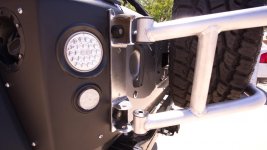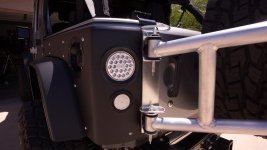Eddie,
Hope you don't take this the wrong way. I have never seen the EVO carrier in real life so I am seeking info not arguing. You are certainly right, by my logic, the weight would all be carried on the driver's side if you switched the bolts. You say that is simply not true, but why?
The EVO carrier setup is unique in that it mounts on super strong rear corners with equally strong driver and passenger mounts. So switching the bolts from passenger to driver side would be possible (the tailgate opening situation might be a little odd).
But consider this..... Just before the carrier is closed, 100% of the weight is held by whatever side has the bolts (hinged side). How can closing the carrier suddenly equally balance the weight between the driver and passenger sides?? I don't see how that is possible. The only weight being transferred from the hinged side to the latched side is the amount of flex in the system. From the photo I quoted above, it looks like you have to lift the latch side of the EVO carrier a couple of inches to seat the arms in the pockets. But I would certainly think the amount of weight you are lifting and thus transferring from the hinged side to the latch side is minor compared to the total weight of the carrier/tire.
And I hope you don't take this the wrong way. I have 2 EVO tire carriers, one on both my Jeeps and I'm not trying to argue anything.
But consider this.... without changing a thing, I can take the passenger side hinge bolts and put them on the driver side and just like that, it opens the other way. Again, without changing a thing, I can also take all the bolts out and let the tire carrier just sits in its 4 mounts. Which side is now holding up most of the weight? :thinking: :idontknow:


